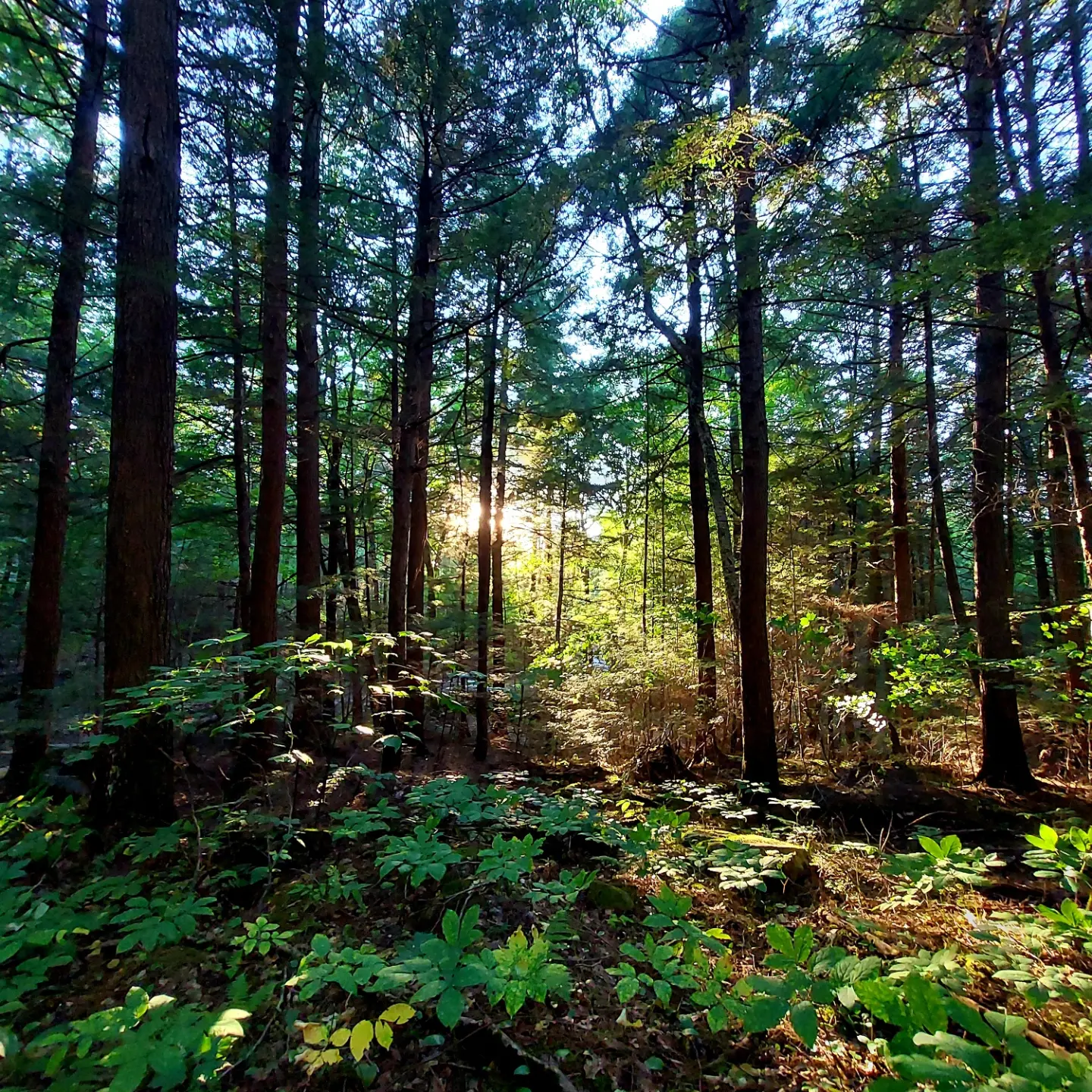Browse "Things"
-
Article
Crown Land
Crown land, sometimes called public land, is the term used to describe land owned by Canada's federal or provincial governments. Authority for control of these public lands rests with the Crown, hence their name. Less than 11% of Canada's land is in private hands; 41% is federal crown land and 48% is provincial crown land. Thus, 89% of land in Canada is Crown land.
"https://d2ttikhf7xbzbs.cloudfront.net/crownland/Light-in-Forest.jpg" // resources/views/front/categories/view.blade.php
https://d2ttikhf7xbzbs.cloudfront.net/crownland/Light-in-Forest.jpg
-
Article
Crown Point
Crown Point is a large peninsula strategically commanding the narrow passage of the southwestern portion of Lake CHAMPLAIN in upper New York State. It was initially the site of Fort Saint-Frédéric, built by the French in 1731 to defend French territory from English colonial invasion.
"https://development.thecanadianencyclopedia.ca/images/tce_placeholder.jpg?v=e9dca980c9bdb3aa11e832e7ea94f5d9" // resources/views/front/categories/view.blade.php
https://development.thecanadianencyclopedia.ca/images/tce_placeholder.jpg?v=e9dca980c9bdb3aa11e832e7ea94f5d9
-
Article
Crow's Nest Pass Agreement
In the 1890s, when rich mineral deposits were discovered in the Kootenay region of southern BC, American developers began to move into the region and extend rail lines northward from their transcontinentals.
"https://development.thecanadianencyclopedia.ca/images/tce_placeholder.jpg?v=e9dca980c9bdb3aa11e832e7ea94f5d9" // resources/views/front/categories/view.blade.php
https://development.thecanadianencyclopedia.ca/images/tce_placeholder.jpg?v=e9dca980c9bdb3aa11e832e7ea94f5d9
-
Article
Crowsnest Pass Strike 1932
This 7-month strike, involving all but one mine in Alberta's CROWSNEST PASS, was the most bitter strike in the region's turbulent history.
"https://development.thecanadianencyclopedia.ca/images/tce_placeholder.jpg?v=e9dca980c9bdb3aa11e832e7ea94f5d9" // resources/views/front/categories/view.blade.php
https://development.thecanadianencyclopedia.ca/images/tce_placeholder.jpg?v=e9dca980c9bdb3aa11e832e7ea94f5d9
-
Article
CRTC
CRTC (Canadian Radio-Television and Telecommunications Commission/Conseil de la radiodiffusion et des télécommunications canadiennes). Established by the Broadcasting Act in 1968 it is an independent agency that regulates and supervises all sectors of the Canadian broadcasting system, including AM and FM radio, television, cable, pay-TV and specialty services.
"https://development.thecanadianencyclopedia.ca/images/tce_placeholder.jpg?v=e9dca980c9bdb3aa11e832e7ea94f5d9" // resources/views/front/categories/view.blade.php
https://development.thecanadianencyclopedia.ca/images/tce_placeholder.jpg?v=e9dca980c9bdb3aa11e832e7ea94f5d9
-
Article
CRTC
CRTC (Canadian Radio-Television and Telecommunications Commission/Conseil de la radiodiffusion et des télécommunications canadiennes).
"https://development.thecanadianencyclopedia.ca/images/tce_placeholder.jpg?v=e9dca980c9bdb3aa11e832e7ea94f5d9" // resources/views/front/categories/view.blade.php
https://development.thecanadianencyclopedia.ca/images/tce_placeholder.jpg?v=e9dca980c9bdb3aa11e832e7ea94f5d9
-
Article
Crustacean
Crustacean, shelled invertebrate with segmented body and limbs at some stage of its life, an exoskeleton and 2 pairs of antennae. The exoskeleton, a protective and supportive framework located outside the body, is periodically molted to allow for growth.
"https://d2ttikhf7xbzbs.cloudfront.net/media/media/cd7b212f-c69d-49e1-a587-e8910ed185c8.jpg" // resources/views/front/categories/view.blade.php
https://d2ttikhf7xbzbs.cloudfront.net/media/media/cd7b212f-c69d-49e1-a587-e8910ed185c8.jpg
-
Article
Fisheries in Canada: Lobsters, Crab and Shrimp
In Canada, all crustacean species with significant economic value are in the order Decapoda. Decapods, which have five pairs of walking legs, include lobsters, crab and shrimp. These species constitute most of the dollar value of Canadian fisheries. In some areas, particularly in the Atlantic provinces, the local economy is almost completely dependent on them.
"https://d2ttikhf7xbzbs.cloudfront.net/media/media/cd7b212f-c69d-49e1-a587-e8910ed185c8.jpg" // resources/views/front/categories/view.blade.php
https://d2ttikhf7xbzbs.cloudfront.net/media/media/cd7b212f-c69d-49e1-a587-e8910ed185c8.jpg
-
Article
Cryptozoology
Cryptozoology is the scientific study of unknown animals about which only circumstantial, or at best insufficient, material evidence is available.
"https://d2ttikhf7xbzbs.cloudfront.net/media/media/ef9da46a-42a2-497c-a807-606470a3398a.jpg" // resources/views/front/categories/view.blade.php
https://d2ttikhf7xbzbs.cloudfront.net/media/media/ef9da46a-42a2-497c-a807-606470a3398a.jpg
-
Article
CS2F Grumman (de Havilland) Tracker
The Tracker was a twin-engine fixed-wing aircraft acquired by the Royal Canadian Navy (RCN) to be flown off aircraft carriers for antisubmarine warfare (ASW) as a replacement for the Grumman Avenger. Originally developed for the United States Navy (USN), a Canadian version was manufactured under licence by de Havilland Canada as the CS2F. After unification the plane was redesignated as the CP-121; the Trackers became shore-based aircraft after the aircraft carrier HMCS Bonaventure was decommissioned. The Trackers became fully operational in 1959 and were withdrawn from service in 1989.
"https://d2ttikhf7xbzbs.cloudfront.net/Tracker.jpg" // resources/views/front/categories/view.blade.php
https://d2ttikhf7xbzbs.cloudfront.net/Tracker.jpg
-
Article
CTrain
CTrain is a light rail transit system in Calgary, Alberta. It is operated by Calgary Transit, a public transit service owned by the City of Calgary and operated through its Transportation Department. Service began on the initial downtown transit corridor and south line in 1981. It expanded to northeast Calgary in 1985, to the University of Calgary in the city’s northwest in 1987 and to the city’s west side in 2012. Most of its route and stations are at surface level. Calgary Transit operates the CTrain in conjunction with an extensive network of bus routes. Through equivalency purchases of wind-generated electricity, it has been entirely wind-powered since 2001. Its two separate lines comprise 45 stations, 118.1 km of track, and an average daily ridership of 312,300 (2018).
"https://d2ttikhf7xbzbs.cloudfront.net/media/media/b027d2ab-b82a-4141-b51c-110cf056a16a.jpg" // resources/views/front/categories/view.blade.php
https://d2ttikhf7xbzbs.cloudfront.net/media/media/b027d2ab-b82a-4141-b51c-110cf056a16a.jpg
-
Macleans
Cuba Downs US Planes
In the end, the protest sputtered out, a victim of high seas and bad weather in the choppy Straits of Florida. The 35 boats and several private planes that set out from Key West, Fla.This article was originally published in Maclean's Magazine on March 11, 1996
"https://development.thecanadianencyclopedia.ca/images/tce_placeholder.jpg?v=e9dca980c9bdb3aa11e832e7ea94f5d9" // resources/views/front/categories/view.blade.php
https://development.thecanadianencyclopedia.ca/images/tce_placeholder.jpg?v=e9dca980c9bdb3aa11e832e7ea94f5d9
-
Article
Cuban Music in Canada
Although there are relatively few Canadians of Cuban origin (379 in 1987), there is a discernible influence of Cuban music on Canadian music, due mainly to its impact on various international styles of pop music, which has often come to Canada via the USA or other Latin American countries. Furthermore, Canadian and Cuban musicians have performed in each other's countries, providing direct musical contact.
"https://development.thecanadianencyclopedia.ca/images/tce_placeholder.jpg?v=e9dca980c9bdb3aa11e832e7ea94f5d9" // resources/views/front/categories/view.blade.php
https://development.thecanadianencyclopedia.ca/images/tce_placeholder.jpg?v=e9dca980c9bdb3aa11e832e7ea94f5d9
-
Macleans
Cuban Dissidents Lose Hope
EITHER MANUEL Vásquez Portal was an idealist, a romantic hero who fought for freedom and democracy in a country where neither exist. Or he was a fool, for waging a public-opinion battle against a dictatorship where public opinion does not exist either.This article was originally published in Maclean's Magazine on March 21, 2005
"https://development.thecanadianencyclopedia.ca/images/tce_placeholder.jpg?v=e9dca980c9bdb3aa11e832e7ea94f5d9" // resources/views/front/categories/view.blade.php
https://development.thecanadianencyclopedia.ca/images/tce_placeholder.jpg?v=e9dca980c9bdb3aa11e832e7ea94f5d9
-
Article
Canada and the Cuban Missile Crisis
The Cuban Missile Crisis lasted from 16 to 28 October 1962. The Soviet Union had stationed nuclear missiles in Cuba, which posed a threat to the United States and Canada. It brought the world to the edge of nuclear war. Canadian armed forces were placed on heightened alert. Prime Minister John Diefenbaker’s hesitant response to the crisis soured already tense relations between Canada and the US and led to the downfall of his government in 1963.
"https://d2ttikhf7xbzbs.cloudfront.net/media/new_article_images/CubanMissileCrisis/578px-Kubkrise1962MRBMSite3.jpg" // resources/views/front/categories/view.blade.php
https://d2ttikhf7xbzbs.cloudfront.net/media/new_article_images/CubanMissileCrisis/578px-Kubkrise1962MRBMSite3.jpg
